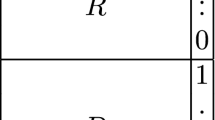Abstract
A symmetric design with parameters v = q 2(q + 2), k = q(q + 1), λ = q, q ≥ 2, is called a quasi-affine design if its point set can be partitioned into q + 2 subsets P 0, P 1,..., P q , P q+1 such that the induced structure in every point neighborhood is an affine plane of order q (repeated q times). A quasi-affine design with q ≥ 3 determines its point neighborhoods uniquely and dual of such a design is also a quasi-affine design. These structural properties pave way for definition of a strongly quasi-affine design and it is also shown that associated with every quasi-affine design is a unique strongly quasi-affine design from which the given quasi-affine design is obtained by certain unique cutting and pasting operation. This investigation also enables us to associate a unique 2-regular graph with q + 2 vertices and in turn, a unique colored partition of the integer q + 2. These combinatorial consequences are finally used to obtain an exponential lower bound on the number of non-isomorphic solutions of such symmetric designs improving the earlier lower bound of 2.
Similar content being viewed by others
References
Ahrens RW, Szekeres G (1969) On a combinatorial generalization of 27 lines associated with a cubic surface. J Austral Math Soc 10:485-492
Andrews GE (1976) The theory of partitions, Encyclopedia of Mathematics and its Applications, vol 2. Reading, MA, (Reprinted, Cambridge University Press, London New York 1984)
Assmus EF, Key JD (1992) Designs and their codes. Cambridge University Press, Cambridge
Beth T, Jungnickel D, Lenz H (1999) Design theory. Cambridge University Press
Dembowski P (1997) Finite geometries. Reprint of the 1968 original Classics in Mathematics. Springer-Verlag, Berlin
Denes J, Keedwell AD (1974) Latin squares and their applications. English Universities Press Limited
Hall M Jr (1986) Combinatorial theory. John Wiley and Sons, New York
Hughes DR, Piper FC (1972) Projective planes, Graduate Texts in Mathematics. Springer-Verlag, New York
Ionin Y, Shrikhande M (2006) Combinatorics of symmetric designs. Cambridge University Press
Jungnickel D (1984) The number of designs with classical parameters grows exponentially. Geom Ded 16:167–178
Lenz H, Jungnickel D (1979) On a class of symmetric designs. Archiv der Math 33(6):590–592
Mavron VC (1988) Symmetric designs and < lambda > arcs. Eur J Combin 9(5):507–516
McFarland RL (1973) A family of difference sets in non-cyclic groups. J Comb Theory Series A 15:1–10
Sane SS (1982) On a class of symmetric designs. In: Vijayan KS, Singhi NM (eds) Combinatorics and applications. Indian Statistical Institute, Calcutta, p. 292–302
Sane SS (2000) Some recent advances on symmetric, quasi-symmetric and quasi-multiple designs. In: Agarwal AK et al (eds) Number Theory and Discrete Mathematics. Centre for Advanced Study in Mathematics, Panjab University, India, pp 81–88, [Birkhauser, Basel (2002)]
Shrikhande SS, Singh NK (1962) On a method of constructing symmetrical balanced incomplete block designs. Sankhya B 24:25–32
Takeuchi K (1963) On the construction of a series of a BIB designs. statist Appel Res JUSTE 10:48
Van Lint JH, Wilson RM (2002) A course in combinatorics. Cambridge University Press, Cambridge
Wallis WD (1971) Construction of strongly regular graphs using affine designs. Bull Austral Math Soc 4:41–49
Author information
Authors and Affiliations
Corresponding author
Additional information
Communicated by D. Jungnickel.
Work of Sanjeevani Gharge is supported by Faculty Improvement Programme of U.G.C., India.
Rights and permissions
About this article
Cite this article
Gharge, S., Sane, S. Quasi-affine symmetric designs. Des Codes Crypt 42, 145–166 (2007). https://doi.org/10.1007/s10623-006-9027-4
Received:
Revised:
Accepted:
Published:
Issue Date:
DOI: https://doi.org/10.1007/s10623-006-9027-4



